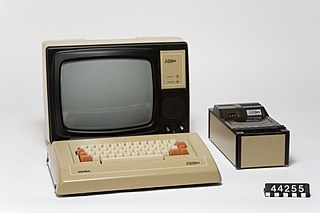 W
WThe ABC 80 was a personal computer engineered by the Swedish corporation Dataindustrier AB (DIAB) and manufactured by Luxor in Motala, Sweden in the late 1970s and early 1980s. It was introduced on the market in August 1978.
 W
WThe Amstrad CPC is a series of 8-bit home computers produced by Amstrad between 1984 and 1990. It was designed to compete in the mid-1980s home computer market dominated by the Commodore 64 and the Sinclair ZX Spectrum, where it successfully established itself primarily in the United Kingdom, France, Spain, and the German-speaking parts of Europe.
 W
WThe Amstrad PCW series is a range of personal computers produced by British company Amstrad from 1985 to 1998, and also sold under licence in Europe as the "Joyce" by the German electronics company Schneider in the early years of the series' life. The PCW, short for Personal Computer Word-processor, was targeted at the wordprocessing and home office markets. When it was launched the cost of a PCW system was under 25% of the cost of almost all IBM-compatible PC systems in the UK, and as a result the machine was very popular both in the UK and in Europe, persuading many technophobes to venture into using computers. However the last two models, introduced in the mid-1990s, were commercial failures, being squeezed out of the market by the falling prices, greater capabilities and wider range of software for IBM-compatible PCs.
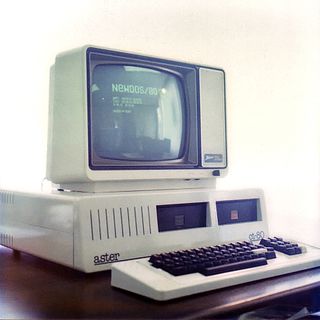 W
WThe Aster CT-80, an early (1982) home/personal computer developed by the small Dutch company MCP, was sold in its first incarnation as a kit for hobbyists. Later it was sold ready to use. It consisted of several Eurocard PCB's with DIN 41612 connectors, and a backplane all based on a 19-inch rack configuration. It was the first commercially available Dutch personal/home computer. The Aster computer could use the software written for the popular Tandy TRS-80 computer while fixing many of the problems of that computer, but it could also run CP/M software, with a big amount of free memory Transient Program Area, (TPA) and a full 80×25 display, and it could be used as a Videotext terminal. Although the Aster was a clone of the TRS-80 Model I it was in fact more compatible with the TRS-80 Model III, and ran all the software of these systems including games. It also had a built in speaker which was compatible with such games software.
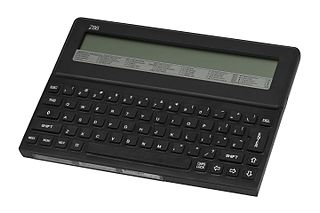 W
WThe Cambridge Computer Z88 is an A4-size, lightweight, portable Z80-based computer with a built-in combined word processing/spreadsheet/database application called PipeDream, along with several other applications and utilities, such as a Z80-version of the BBC BASIC programming language.
 W
WThe Lynx was an 8-bit British home computer that was first released in early 1983 as a 48 kB model. Several models were available with 48 kB, 96 kB or 128 kB RAM. It was possible to reach 192 kB with RAM expansions on board. John Shireff designed the hardware and Davis Jansons the firmware.
 W
WThe CCE MC-1000 was an obscure Home computer produced in Brazil by CCE. Not much is known about the machine, but it seems clear that it owned its heritage to the Belgian GEM 1000, and the Rabbit RX83 which were systems produced in Hong-Kong by the firm "Rabbit computers”. It was launched a year after the MC 4000, an Apple 2 clone.
 W
WThe Coleco Adam is a home computer and expansion device for the ColecoVision released in 1983 by American toy and video game manufacturer Coleco. It was an attempt to follow on the success of the company's ColecoVision video game console. The Adam was not very successful, partly because of early production problems, and was discontinued in early 1985.
 W
WThe EACA EG2000 Colour Genie was a computer produced by Hong Kong-based manufacturer EACA and introduced in Germany in August 1982. The company went bankrupt when its founder left it with a suitcase of money. TCS in Germany St, Augustin, near Bonn went bankrupt later. It followed their earlier Video Genie I and II computers and was released around the same time as the business-oriented Video Genie. The BASIC was compatible with the Video Genie I and II and the TRS-80, except for graphic and sound commands; most of the routines for Video Genie I BASIC commands were left over in the Colour Genie's BASIC ROM. Programs were provided to load TRS-80 programs into the Colour Genie. Colour Genie disks could be read in a TRS-80 floppy disk drive and vice versa, editing the pdrive commands.
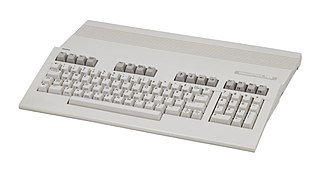 W
WThe Commodore 128, also known as the C128, C-128, C= 128, is the last 8-bit home computer that was commercially released by Commodore Business Machines (CBM). Introduced in January 1985 at the CES in Las Vegas, it appeared three years after its predecessor, the bestselling Commodore 64.
 W
WCompucolor is a series of color microcomputers introduced by Compucolor Corporation of Norcross, Georgia. It was the first color home computer system with built-in color graphics and floppy-based data storage. It used the Intel 8080 CPU.
 W
WThe DAI personal computer is a rare, early home computer from the Belgian company Data Applications International. The DAI came to market in 1980. It provided many pioneering features such as high resolution color graphics, a maths co-processor, and a pre-compiling BASIC interpreter. However, it never became a commercial success.
 W
WThe Dick Smith Super-80 was a Zilog Z80 based kit computer developed as a joint venture between Electronics Australia magazine and Dick Smith Electronics. It was presented as a series of construction articles in Electronics Australia magazine's August, September and October 1981 issues.
 W
WVideo Genie is a discontinued series of computers produced by Hong Kong-based manufacturer EACA during the early 1980s. Computers from the Video Genie line are mostly compatible with the Tandy TRS-80 Model I computers and can be considered a clone, although there are hardware and software differences.
 W
WThe VTech Laser 200 was an early 8-bit home computer from 1983, also sold as the Salora Fellow, the Seltron 200 in Hungary and Italy, the Smart-Alec Jr. by Dynasty Computer Corporation in Dallas, Texas for the USA, the Texet TX8000A, and the Dick Smith VZ 200 and the VTech VZ 200.
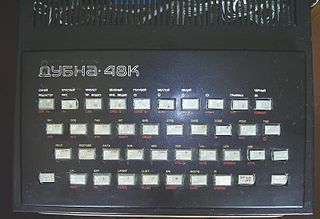 W
WThe Dubna 48K is a Soviet clone of the ZX Spectrum home computer. It was based on an analogue of the Zilog Z80 microprocessor. Its name comes from Dubna, a town near Moscow where it was produced, and "48K" stands for 48 KBs of RAM.
 W
WThe Enterprise is a Zilog Z80-based home computer announced in 1983, but through a series of delays, not commercially available until 1985. The specification as released was powerful and one of the higher end in its class. This was due to the use of ASICs for graphics and sound which took workload away from the CPU, an extensive implementation of ANSII BASIC and a bank switching system to allow for larger amounts of RAM than the Z80 natively supported. It also featured a distinctive and colourful case design, and promise of multiple expansion options. Ultimately it was not commercially successful, after multiple renames, delays and a changing market place. Its manufacturer calling in the receivers in 1986 with significant debt. It was developed by British company Intelligent Software and marketed by Enterprise Computers. Its two variants are the Enterprise 64, with 64 kilobytes of Random Access Memory (RAM), and the Enterprise 128, with 128 KB of RAM.
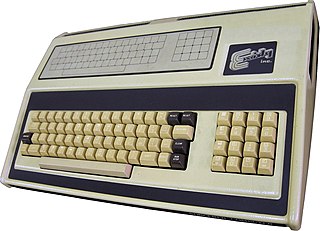 W
WThe Sorcerer is a home computer system released in 1978 by the video game company Exidy. It was comparatively advanced when released, especially when compared to the contemporary more commercially successful Commodore PET and TRS-80, but due to company focus on the coin operated video game marketplace resources were restricted for personal computer expansion and a separate division of the company was created. Exidy Data Systems was headed by Paul Terrell to expand the product line to include small business computing with international distribution and technology license agreements to supplement corporate funding. Distribution agreements with Dick Smith Electronics in Australia and Liveport in the UK as well as Compudata which included a manufacturing license to build, market and distribute the Tulip line of computers in Europe. Exidy sold the PC division to a Wall Street firm, Biotech, in 1983.
 W
WThe Galaksija was a build-it-yourself computer designed by Voja Antonić. It was featured in the special edition Računari u vašoj kući of a popular eponymous science magazine, published late December 1983 in Belgrade, Yugoslavia. Kits were available but not required as it could be built entirely out of standard off-the-shelf parts. It was later also available in complete form.
 W
WThe Grundy NewBrain was a microcomputer sold in the early 1980s by Grundy Business Systems Ltd of Teddington and Cambridge, England.
 W
WHobbit (Хоббит) is a Soviet/Russian 8-bit home computer, based on the Sinclair ZX Spectrum hardware architecture. It also featured a CP/M mode and Forth mode or LOGO mode, with the Forth or LOGO operating environment residing in an on-board ROM chip.
 W
WThe IQ 151 was a personal computer produced by ZPA Nový Bor in the former Czechoslovakia.
 W
WThe Jupiter Ace by Jupiter Cantab was a British home computer of the early 1980s. The Ace differed from other microcomputers of the time in that its programming environment used Forth instead of the more popular BASIC.
 W
WThe KC 85 were models of microcomputers built in East Germany, first in 1984 by VEB Robotron and later by VEB Mikroelektronik "Wilhelm Pieck" Mühlhausen.
 W
WThe Lambda 8300 was a Sinclair ZX81 clone from Lambda Electronics Limited of Hong Kong. It was not an exact clone, as it had a modified ZX81 ROM, but could be fitted with a ZX81 compatible ROM. It came with 2K RAM, and a sound and joystick port. Specifically, it used a Z80A microprocessor at 3.25 MHz. Unisonic distributed it as the Futura 8300 in the US. The computer was somewhat successful in Northern Europe and China, and today enthusiasts still develop new hardware.
 W
WThe educational computer LC80 was a single-board computer manufactured in the German Democratic Republic (GDR) and intended for teaching purposes. It was the first computer that retail customers could buy in the GDR.
 W
WAquarius is a home computer designed by Radofin and released by Mattel Electronics in 1983. It features a Zilog Z80 microprocessor, a rubber chiclet keyboard, 4K of RAM, and a subset of Microsoft BASIC in ROM. It connects to a television set for audio and visual output, and uses a cassette tape recorder for secondary data storage. A limited number of peripherals, such as a 40-column thermal printer, a 4-color printer/plotter, and a 300 baud modem, were released for the unit. It was discontinued in October 1983.
 W
WThe Memotech MTX500, MTX512 and RS128 are a series of Zilog Z80A processor-based home computers released by Memotech in 1983 and 1984. They were technically similar to MSX computers, but were not compatible.
 W
WThe Micro-Professor MPF-I, introduced in 1981 by Multitech, was the first branded computer product from Multitech and probably one of the world's longest selling computers. The MPF-I, specifically designed to teach the fundamentals of machine code and assembly language, is a simple and easy to use training system for the Zilog Z80 microprocessor.
 W
WMicroBee was a series of networkable home computers by Applied Technology, which became publicly listed company MicroBee Systems Limited soon after its release.
 W
WMSX is a standardized home computer architecture, announced by Microsoft and ASCII Corporation on June 16, 1983. It was initially conceived by Microsoft as a product for the Eastern sector, and jointly marketed by Kazuhiko Nishi, then vice-president at Microsoft and director at ASCII Corporation. Microsoft and Nishi conceived the project as an attempt to create unified standards among various home computing system manufacturers of the period, in the same fashion as the VHS standard for home video tape machines.
 W
WThe MUPID was an early home computer like system (1981-1983) designed and invented by Hermann Maurer for the University of Graz to be used as a Bildschirmtext terminal, but it was also capable of being used as a stand-alone computer. At the time it excelled in having advanced color graphic capabilities. It was followed in 1983 by the MUPID II. A card for older IBM PC-compatibles with an ISA slot was developed that gave a PC the same graphics capabilities as a MUPID.
 W
WThe Nascom 1 and 2 were single-board computer kits issued in the United Kingdom in 1977 and 1979, respectively, based on the Zilog Z80 and including a keyboard and video interface, a serial port that could be used to store data on a tape cassette using the Kansas City standard, and two 8-bit parallel ports. At that time, including a full keyboard and video display interface was uncommon, as most microcomputer kits were then delivered with only a hexadecimal keypad and seven-segment display. To minimize cost, the buyer had to assemble a Nascom by hand-soldering about 3,000 joints on the single circuit board.
 W
WThe Osborne 1 is the first commercially successful portable microcomputer, released on April 3, 1981 by Osborne Computer Corporation. It weighs 10.7 kg (24.5 lb), cost US$1,795, and runs the CP/M 2.2 operating system. It is powered from a wall socket, as it has no on-board battery, but it is still classed as a portable device since it can be hand-carried when packed.
 W
WThe Osborne Executive was the planned successor of the already commercially successful Osborne 1 portable computer by Osborne Computer Corporation. The Executive was a collection of the good features from the Osborne 1 and fixed some of its predecessor's flaws.
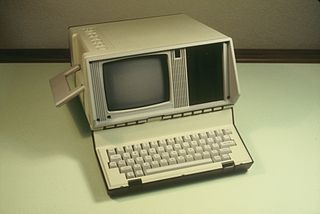 W
WThe Osborne Vixen was a "luggable" portable computer announced by the Osborne Computer Corporation in November 1984, as a follow up to their Osborne 1 and Osborne Executive system.
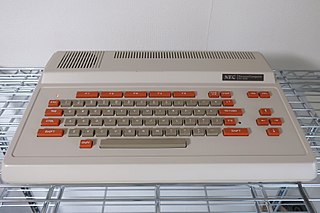 W
WThe NEC PC-6000 Series is a series of 8-bit home computers introduced in November 1981 by NEC Home Electronics (NEC-HE). There are several models in this series, such as the PC-6001, the PC-6001 MK2 and the PC-6001 MK2 SR. There is also an American version, called the NEC TREK, or NEC PC-6001A. It was followed by the PC-6600 Series.
 W
WThe PC-8000 series is a line of personal computers developed for the Japanese market by NEC. The PC-8001 model was also sold in the United States and Canada as the PC-8001A.
 W
WThe PC-8800 series , commonly shortened to PC-88, are a brand of Zilog Z80-based 8-bit home computers released by Nippon Electric Company (NEC) in 1981 and primarily sold in Japan.
 W
WThe Philips P2000T home computer was Philips' first real entry in the home computer market, after the Philips Videopac G7000 game system which they already sold to compete with the Atari 2600 and similar game systems. There was also a P2000M version with an additional 80-column card for use with a monochrome monitor. This version shipped with a monitor cabinet also housing a dual 5.25" floppy drive.
 W
WThe VG5000μ is a computer created by Philips in 1984. It was manufactured in Le Mans by Radiotechnique (RTS) and marketed under the Philips, Radiola and Schneider brands. Production ended in 1986.
 W
WThe Research Machines 380Z was an early 8-bit microcomputer produced by Research Machines in Oxford, England, from 1977 to 1985.
 W
WThe SAM Coupé is an 8-bit British home computer that was first released in late 1989. It was designed to have compatibility with the Sinclair ZX Spectrum, albeit in 48K mode only. It features a compatible screen mode and emulated compatibility, and was marketed as a logical upgrade from the Spectrum. It was originally manufactured by Miles Gordon Technology (MGT), based in Swansea in the United Kingdom.
 W
WThe Sharp MZ is a series of personal computers sold in Japan and Europe by Sharp beginning in 1978.
 W
WThe X1 , sometimes called the Sharp X1, is a series of home computers released by Sharp Corporation from 1982 to 1988. It was based on a Z80 CPU.
 W
WThe SMC-70 is a microcomputer that was produced by Sony and released in 1982. The system was initially released for general office use in the United States, with the SMC-70G and SMC-70GP designed for professional video generation, for example in cable television applications, and digital video effect generation. It was the first computer that used the recently invented 3.5" micro floppy disk drive that was modified to become the industry standard. Like many home and office computers of the era, it had its own specially developed version of BASIC. Sony BASIC was designed to take advantage of a color Sony Trinitron display. The SMC-70 did not run Microsoft BASIC, despite the system being designed to compete in the US market. With optional expansion ROMs the system could display kanji characters.
 W
WThe Sord M5 is a home computer launched by Sord Computer Corporation in 1982. Primarily the Sord M5 competed in the Japanese home computer market. It was also sold as the CGL M5 in the United Kingdom by Computer Games Limited and was reasonably popular in Czechoslovakia, where the M5 stood as one of the first affordable computers available to the general public. Takara also sold models in Japan as the Game M5, and models were also exported to South Korea.
 W
WThe SPC-1000 is a Z80-based personal computer produced by Samsung. It was developed in South Korea, but featured built-in BASIC written by Hudson Soft in Japan. The computer features a 4 MHz processor and 64 KB of RAM.
 W
WThe ZX Spectrum is an 8-bit personal home computer released in the United Kingdom in 1982 by Sinclair Research.
 W
WSinclair ZX Spectrum Next is a modern 8-bit home computer, backwards compatible with the ZX Spectrum both in software and hardware, but also featuring enhanced capabilities. It is intended to appeal to retro-computing enthusiasts and also to "encourage a new generation of bedroom coders", according to project member Jim Bagley.
 W
WThe Tatung Einstein is an eight-bit home/personal computer produced by Taiwanese corporation Tatung, designed in Bradford, England at Tatung's research laboratories and assembled in Bridgnorth and Telford, England. It was aimed primarily at small businesses.
 W
WTiki-100 was a desktop home/personal computer manufactured by Tiki Data of Oslo, Norway. The computer was launched in the spring of 1984 under the original name Kontiki-100, and was first and foremost intended for the emerging educational sector, especially for primary schools. Early prototypes had 4 KB ROM, and the '100' in the machine's name was based on the total KB amount of memory.
 W
WTIM 011 is an educational or personal computer for school microcomputer developed by Mihajlo Pupin Institute of Serbia in 1987. There were about 1200 TIM-011 computers in Serbian schools in the 1990s.
 W
WThe Timex Sinclair 1000 (TS1000) was the first computer produced by Timex Sinclair, a joint venture between Timex Corporation and Sinclair Research. It was launched in July 1982, with a US sales price of US$99.95, making it the cheapest home computer at the time; it was advertised as "the first computer under $100". The computer was aimed at regular home users. Unlike earlier computers aimed at home users, the TS1000 was not a kit which had to be soldered and assembled. As purchased, the TS1000 was fully assembled and ready to be plugged into the users' home TV. The TS1000 was a slightly modified version of the Sinclair ZX81 with an NTSC RF modulator, for use with North American TVs, instead of PAL for European TVs. The TS1000 doubled the onboard RAM from 1 KB to 2 KB. The TS1000's casing had slightly more internal shielding but remained the same as Sinclair's, including the membrane keyboard. It had black-and-white graphics and no sound. It was followed by an improved version, the Timex Sinclair 1500 which had substantially more RAM and a lower price (US$80). However, the TS1500 did not achieve market success, given that the marketplace was by this time dominated by Commodore, RadioShack, Atari and Apple.
 W
WThe TRS-80 Micro Computer System is a desktop microcomputer launched in 1977 and sold by Tandy Corporation through their RadioShack stores. The name is an abbreviation of Tandy/RadioShack, Z80 microprocessor. It is one of the earliest mass-produced and mass-marketed retail home computers.
 W
WVideo Genie is a discontinued series of computers produced by Hong Kong-based manufacturer EACA during the early 1980s. Computers from the Video Genie line are mostly compatible with the Tandy TRS-80 Model I computers and can be considered a clone, although there are hardware and software differences.
 W
WThe VTech Laser 200 was an early 8-bit home computer from 1983, also sold as the Salora Fellow, the Seltron 200 in Hungary and Italy, the Smart-Alec Jr. by Dynasty Computer Corporation in Dallas, Texas for the USA, the Texet TX8000A, and the Dick Smith VZ 200 and the VTech VZ 200.
 W
WThe VTech Socrates is an 8-bit educational home video game console manufactured and released in 1988 by VTech. The console features a robot character Socrates, named after the philosopher. The character is visually similar to Johnny Five from the Short Circuit movies. It was discontinued in the early 1990s.
 W
WThe Sinclair ZX80 is a home computer launched on 29 January 1980 by Science of Cambridge Ltd.. It is notable for being one of the first computers available in the United Kingdom for less than a hundred pounds. It was available in kit form for £79.95, where purchasers had to assemble and solder it together, and as a ready-built version at £99.95. The ZX80 was very popular straight away, and for some time there was a waiting list of several months for either version of the machine.
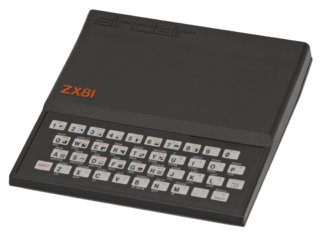 W
WThe ZX81 is a home computer that was produced by Sinclair Research and manufactured in Dundee, Scotland, by Timex Corporation. It was launched in the United Kingdom in March 1981 as the successor to Sinclair's ZX80 and designed to be a low-cost introduction to home computing for the general public. It was hugely successful; more than 1.5 million units were sold. In the United States it was initially sold as the ZX-81 under license by Timex. Timex later produced its own versions of the ZX81: the Timex Sinclair 1000 and Timex Sinclair 1500. Unauthorized ZX81 clones were produced in several countries.